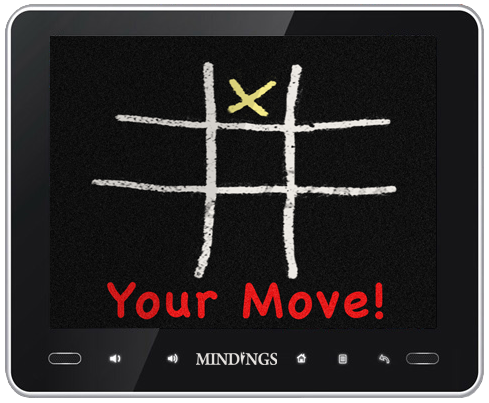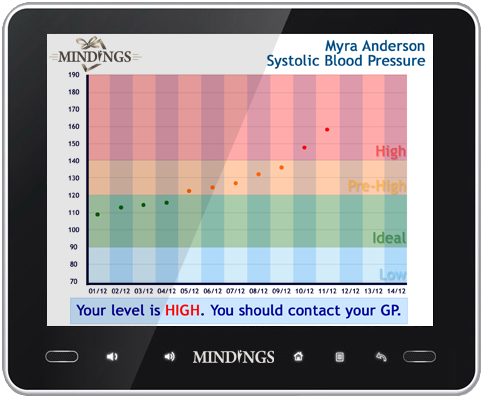
“I’m better connected to people I deliberately lost touch with over the years than to the people I really care about.”
With 15+ years experience as a multimedia producer, Stuart Arnott has done everything from making science documentaries for the BBC and producing TV commercials, to creating corporate videos and websites. He’s even got a few ‘industry firsts’ under his belt: “I produced one of the world’s first PAL DVDs”, says Arnott. “And I’ve picked up a fair few awards along the way too.”
The Next Web was at the PowerOfOne Conference in early November, one of the many events that constituted Internet Week Europe. Whilst we reported on a couple of stories relating to the event, involving Jason Calacanis, and Yosi Taguri, it was Stuart Arnott‘s pitch that really caught our attention.
Stuart has been working on an interesting new product called Mindings, which he presented to the audience at the Power of One conference after winning a competition to pitch his product. In the simplest terms, Mindings strives to harness the power of social technology and connect people with family members who are dissociated with the digital age.
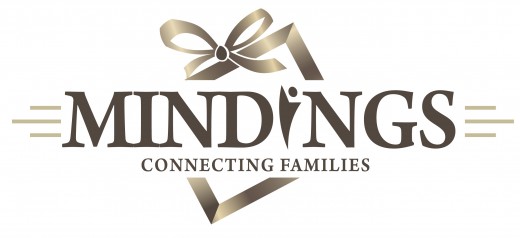
“Just before my daughter was born, in March 2008, my Mum was diagnosed with cancer”, says Stuart. “As she and my dad lived miles away, I realized she was not going to see my daughter – her only granddaughter – more than half-a-dozen times. So, I wanted to give her as much of ‘the grandmother experience’ as possible.”
At first, Stuart printed out a bunch of photos, stuck a stamp on them, wrote his mum’s address on the back and posted them as though they were postcards. “After a while I thought, ‘I’m a geek, surely I can do better than this?'”, says Stuart. “So after searching the Web I discovered one of the first wireless picture frames that you could email pictures to. It was very poor quality, a pain to use and when I visited I had to manually remove the old photos.”
However, it was the ability to send photos in this manner – without the hassle of printing photos and posting them – and his mother being able to see her granddaughter every day that really amazed Stuart. “I looked around for a better solution, and there wasn’t one”, says Stuart. “So, drawing on my background as a multimedia producer, I decided to make something myself. And it has developed since. I’ve been working on Mindings as it currently stands for almost a year now. I pretty much devote about 80% of my working life to it.”
Mindings is a bootstrapped company, which means Stuart still dabbles in the multimedia production game to help ends meet. “I have Angels in the wings though”, adds Stuart. “But until we have a product that a sufficient number of people are using, or a hardware manufacturer that wants to do a deal, I’m resisting accepting money. Or maybe until my credit cards say ‘no more’.”
So that’s the back-story. But what, exactly, is Mindings?
Mindings: Connecting families
There’s little question that many of you reading this will know of someone who would benefit from being better connected to the wider world – whether it’s an auntie, grandparent or an old best friend. But what exactly does Mindings do to help connect people?
“Mindings is a Web app and a back-end service”, says Stuart. “As well as my Dad having prototype number one on his mantlepiece, we have Mindings Android app on some tablets – the Binatone 705.”
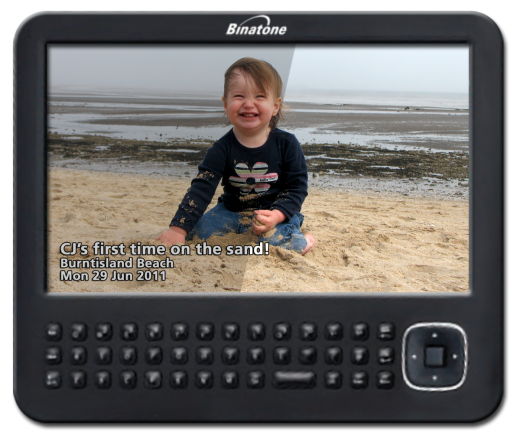
“When people start using Mindings, they will become dependent on it”, says Stuart. “They’ll start trusting it – it will most likely be given to a vulnerable person. I want to make sure that this is something that works. Even if I say ‘don’t use this to remind granny to take her medicine’, people will do that – and I have a sense of personal responsibility about that.”
Stuart’s immediate goal is to have Mindings integrated with digital photo-frames that sit on a relative’s mantlepiece. There is a website that administrators can log-on to change the settings remotely – the administrator would likely be the person who bought the device for the relative. But there’s scope for a branded Mindings device too. “We have the technology in place now, and we’d like to do a deal with a hardware manufacturer to make a bespoke Mindings device”, says Stuart. “We have already been speaking to a company which discussed re-skinning an existing Android e-Book device to do just that, as re-tooling an existing device is much cheaper than making one from scratch.”
The key Mindings offering at present is that it enables a device to receive and display captioned photographs, SMS text messages, Facebook Statuses & photos, and a calendar. “We plan to include all manner of other applications in the future, such as Twitter, Flickr, Instant Messenger etc”, says Stuart.
Although there is an existing Android app which allows Mindings to run on tablet devices, access is limited to a small number of testers until, he says, it’s ‘rock-solid’. “We’re currently focused on our other product, ‘webMindings’, which is a browser-based version of the product”, says Stuart. “We have been asked so many times ‘can’t you just make it run on a computer or laptop we bought mum/dad/granny last Christmas, for which we had broadband installed’. We realized just recently that this would be an easy win for us, to get people using Mindings. Instead of having to persuade people to buy an Android tablet and get broadband installed at granny’s house, we’d just offer it to people who already have the kit and connection.”
Stuart thinks there are enough people out there in that situation to really start getting the product some traction. “How many people have an old laptop kicking around?”, asks Stuart. “I know I have at least three I can think of, plus the shop down the road sells refurbished models for less than a hundred pounds. Add to that the fact that half of UK households have wireless broadband – which means that most people have a wireless connection they can ask their neighbor if they could leech, to send granny some pictures. Who’d say no?”
Still, there’s room for clarification here in terms of how the actual interaction works. Remember, we’re not talking about standard tablet devices or picture frames here – we’re talking about a two-way interactive device that sits as part of a livingroom’s furnishings and is always on, displaying updates from somewhere else in the world. But it’s largely passive, and no real technical expertise is required.
“We have a big thumbs-up graphic on the bottom right of the screen, which is called GotIt!“, says Stuart. “This appears when I send my dad a new text message. If he touches the graphic I receive a text message in return, so I know that he got my message.”
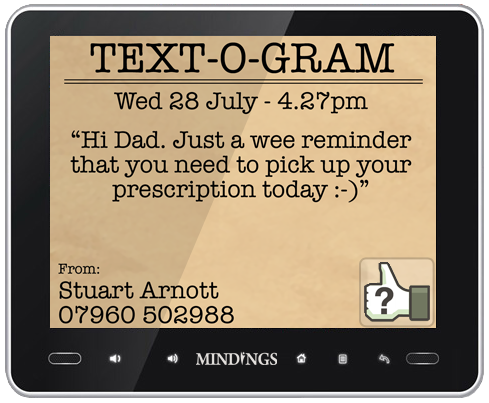
“If I’m sending dad a text message, I’m specifically sending it to elicit a response, one that basically says ‘I’m alive’. I’m uploading content to Facebook all day long for anyone to see. If dad ‘Likes’ a picture, he doesn’t know what ‘Like’ is in the context of Facebook, he just thinks he’s letting me know he received the picture. I get the notification that dad is okay, and I’m passively getting that piece-of-mind even when I’m not actively seeking it.”
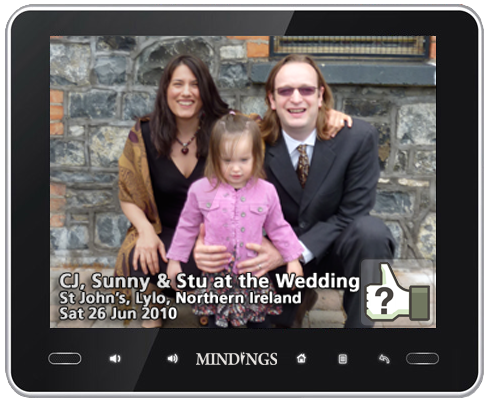
Future incarnations may include the ability to send a text message from the device too, perhaps pre-written such as ‘call me when you have a moment’. But Stuart is keen to stress that this isn’t simply a tablet device. It is all about simplicity, so it’s not likely to be extended much beyond that. This isn’t meant to be an iPad.
Mindings as a healthcare platform
Whilst Mindings is still in its infancy, Stuart sees a much bigger potential for the technology, and he’s building the technology with one eye on the future. “I have a Senior Developer here in London with who I work closely on a daily basis, and I have a development team in the Philippines”, says Stuart. “I also have a team of advisors, in financial, marketing and strategy roles.”
Stuart’s broader ambition for Mindings is for it to move into the consumer telecare device market. “When my Mum passed away, dad was left living alone”, says Stuart. “Ironically, my dad had bad health, and he’s virtually housebound and my mum, despite her cancer, was my dad’s carer. We got in the local health authority who assessed dad and we were told that, yes, he was sufficiently disabled to qualify for a stair lift, a panic alarm, a daily health visitor wake-up service and a whole bunch of disability aids. This was great, except that the local authority’s budget had run out.
“After a lot of fuss and numerous visits to our local MP, we got the wake-up service but we had to buy the stairlift ourselves. It turns out that other monitoring devices can only be installed and run by health authorities. I thought that was crazy – I can buy a burglar alarm from Argos, why can’t I buy a TeleCare system to look after my family? With Mindings, I want to fix this wrong.”
So the GotIt! feature would become part of a home monitoring system. “You can either fill your loved-one’s home with webcams, motion detectors, trip-switches and remove their dignity and belief that they are able to live alone”, says Stuart. “Or you can buy Mindings, send them pictures and messages that will brighten up their life, and get the same regular stream of feedback that they are well. Next, I hope to be connecting health devices, so my dad takes his blood pressure reading and it appears on a simplified graph in the Mindings stream of content. Simultaneously, I get the same graph. Dad knows he’s okay, I know he’s okay. I can then let the doctor view the data at his next appointment on a secure Web page.”
Furthermore, Stuart told me about an interesting study that took place with Mindings recently. “During the summer, we did a clinical study at a major brain injuries unit”, says Stuart. “If you’ve had a brain trauma, the patients can be in there for anything up to 9 months. We had a number of patients use Mindings for a period of 5 weeks, the full data is being presented shortly. But the reaction, I can tell you, has been amazing.
“We set out to see if we could improve people’s memories, and what we discovered was it did – but not in the way we expected. If we showed them a photo, and it was on all day by their bed, when we tested them on things like ‘what color of jacket was the person wearing’, there was no improvement. But their recall of the event was amazing – and it was in such detail too. So we’d have a photo of a birthday party, or wedding reception and the detail they could recall from that was amazing.”
“I want this to be a consumer telecare device”, added Stuart. “But that’s the next step. We’re not trying to be like Tunstall, in making home telecare devices, like big ugly medical devices that sit in the corner of the room frightening people. Mindings is a social device.”
So…when can I start using Mindings?
The technology that can be integrated with photo-frames, tablets and such like is pretty much good to go, though you’ll not be able to access it quite yet. “We hope to be testing connected devices in the New Year”, says Stuart. First up is likely to be what’s known as ‘Web Mindings’, which will be a Web app that can run on any old computer. With more users on board and armed with some impressive stats to take to interested parties, Stuart hopes to lure some manufacturers on board to build a bespoke Mindings device.
Finally, the one stand-out line from Stuart’s pitch at the PowerOfOne conference a few weeks back seemed to resonate with a lot of people at the event:
“I’m better connected to people I deliberately lost touch with over the years than to the people I really care about.”
“I constructed that line”, says Stuart. “It was one of these moments where I was trying to drill-down Mindings to its very essence. Is it a product? Is it a service? That’s the line that gets everybody though.”
Check out the official Mindings promo video here:
Get the TNW newsletter
Get the most important tech news in your inbox each week.

